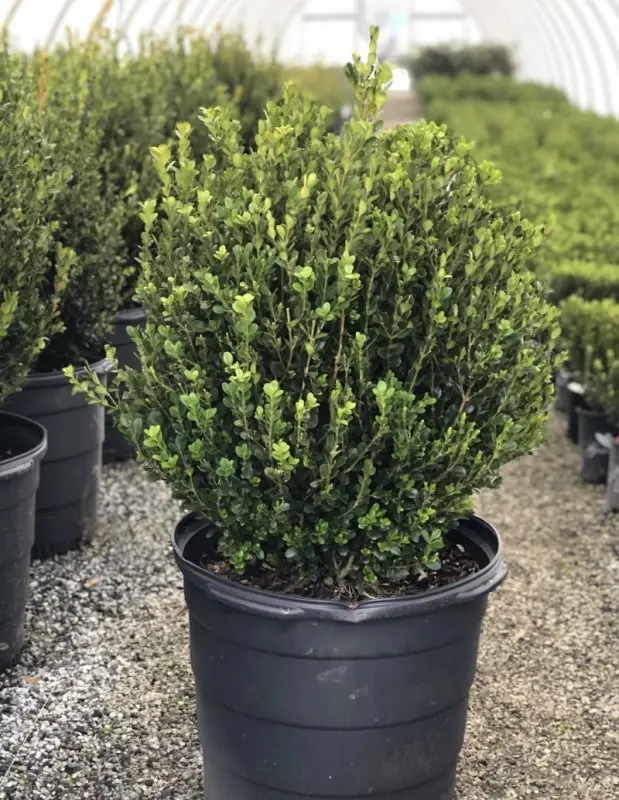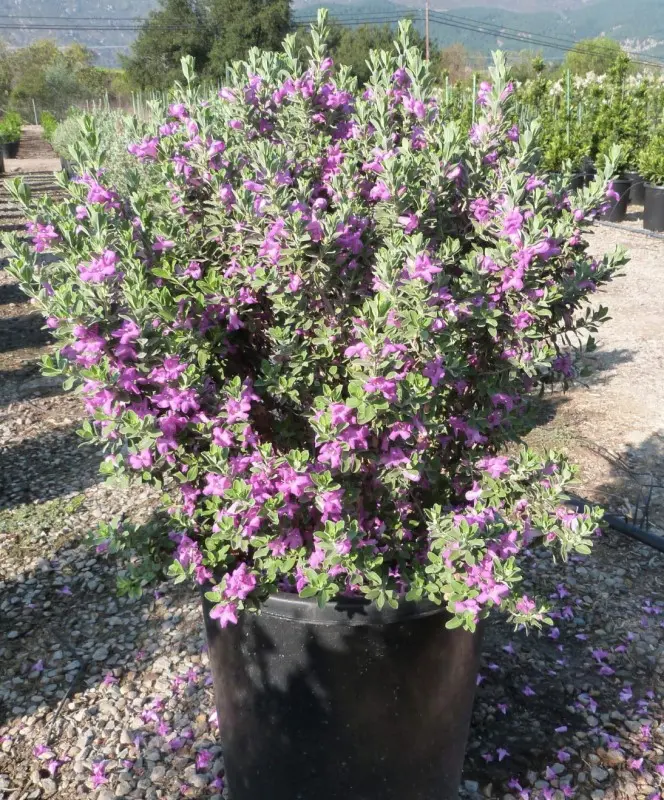
Texas Sage
$0.00
Full sun
-
3'-8'
Deer resistant
Texas Sage (Leucophyllum frutescens), also known as Cenizo, Texas Ranger, or Silverleaf, is a hardy, drought-tolerant shrub prized for its silvery-gray foliage and vibrant blooms. Native to the southwestern United States and northern Mexico, Texas Sage produces beautiful purple, lavender, or magenta flowers after periods of rain or humidity, often creating a stunning display in the late summer and fall. The blooms are tubular, attracting pollinators like bees and butterflies, and contrast strikingly with the plant’s soft, silvery leaves.
This shrub typically grows 3 to 6 feet tall and wide, though it can reach up to 8 feet in ideal conditions. Texas Sage thrives in USDA zones 8-11 and prefers full sun, where it will produce the most prolific blooms and dense foliage. It is highly adaptable to various soil types, including rocky, sandy, or alkaline soils, as long as they are well-draining. Texas Sage is also highly heat- and drought-tolerant once established, making it perfect for xeriscaping and low-water landscapes.
Requiring minimal maintenance, Texas Sage can be lightly pruned to shape, especially in spring, but it generally maintains a neat, rounded form. It is resistant to pests and diseases, adding to its popularity as a low-maintenance choice for landscapes. Texas Sage is commonly used as a hedge, border, or specimen plant, adding both color and texture to desert, southwestern, or coastal garden designs. With its resilience, stunning flowers, and silvery foliage, Texas Sage is an iconic and attractive choice for hot, dry climates.
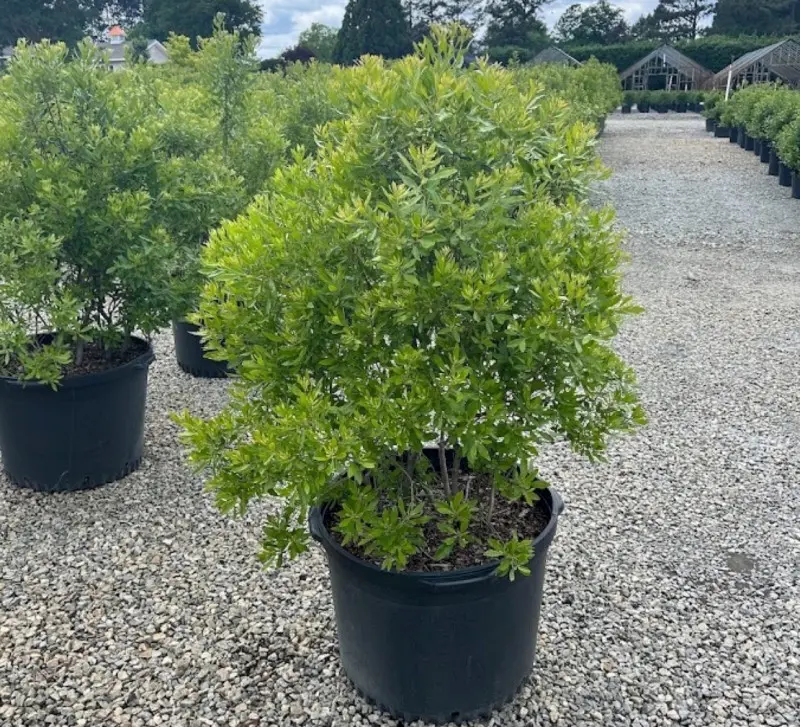
Wax Myrtle
$0.00
Full sun
Partial sun
6'-20'
Not deer resistant
Wax Myrtle (Myrica cerifera), also known as Southern Wax Myrtle or Southern Bayberry, is a versatile, fast-growing evergreen shrub or small tree admired for its aromatic foliage and natural resilience. Native to the southeastern United States, Wax Myrtle has narrow, lance-shaped, olive-green leaves that emit a pleasant fragrance when crushed. In fall, female plants produce clusters of small, waxy, bluish-gray berries along the stems, which provide food for birds and wildlife throughout winter. The berries have historically been used to make bayberry candles due to their high wax content.
Wax Myrtle can grow between 10 to 20 feet in height, with a similar spread, though it can be pruned to maintain a smaller size or shaped into a hedge. This shrub thrives in USDA zones 7-10 and is adaptable to a variety of soil types, including sandy, acidic, and poorly draining soils. Wax Myrtle is drought-tolerant once established and highly resistant to salt, making it well-suited for coastal landscapes and xeriscape gardens. It performs best in full sun to partial shade.
Low-maintenance and pest-resistant, Wax Myrtle requires minimal pruning, though it can be trimmed in late winter or early spring to shape and control growth if used as a hedge or screen. It is also deer-resistant and helps with erosion control, making it a practical choice for naturalized settings, slopes, or privacy screens. With its fragrant foliage, wildlife-friendly berries, and tolerance to challenging conditions, Wax Myrtle is a valuable addition to both formal and informal landscapes, bringing beauty and functionality year-round.
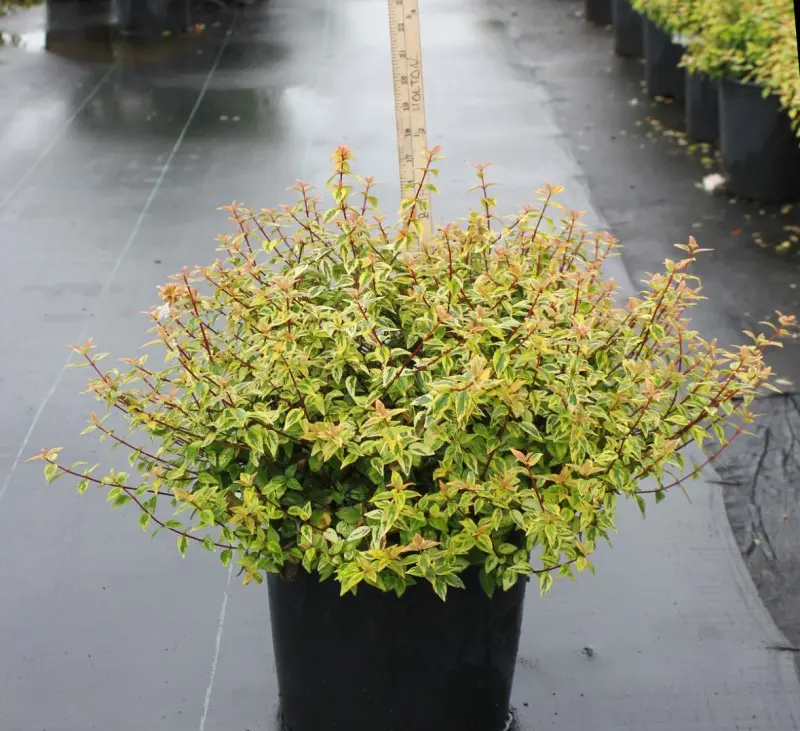
Kaleidoscope Abelia
$0.00
Full sun
-
1'-3'
Not deer resistant
Kaleidoscope Abelia (Abelia x grandiflora ‘Kaleidoscope’) is a stunning, evergreen shrub known for its vibrant, ever-changing foliage and compact growth habit. This variety of Abelia features variegated leaves that transition in color throughout the year, creating a "kaleidoscope" effect. In spring, the leaves emerge with a bright green center and golden-yellow edges. As the seasons progress, the yellow intensifies, and by fall, the foliage takes on rich shades of orange and red, adding warm hues to the landscape. Small, fragrant white or pale pink tubular flowers bloom from late spring through fall, attracting pollinators like bees and butterflies.
Kaleidoscope Abelia typically grows 2 to 3 feet tall and 3 to 4 feet wide, forming a low, mounding shape that works well for borders, foundation plantings, or container gardens. It thrives in full sun to partial shade and is hardy in USDA zones 6-9. This shrub prefers well-draining soil and is relatively drought-tolerant once established, making it suitable for low-maintenance and water-wise landscapes.
Requiring minimal care, Kaleidoscope Abelia benefits from light pruning in early spring to maintain its shape and promote fresh growth. Its resistance to pests and diseases, along with its year-round color, makes it a popular choice for adding long-lasting visual interest. With its changing foliage, fragrant blooms, and ease of care, Kaleidoscope Abelia is a versatile and colorful addition to both formal and informal garden designs.
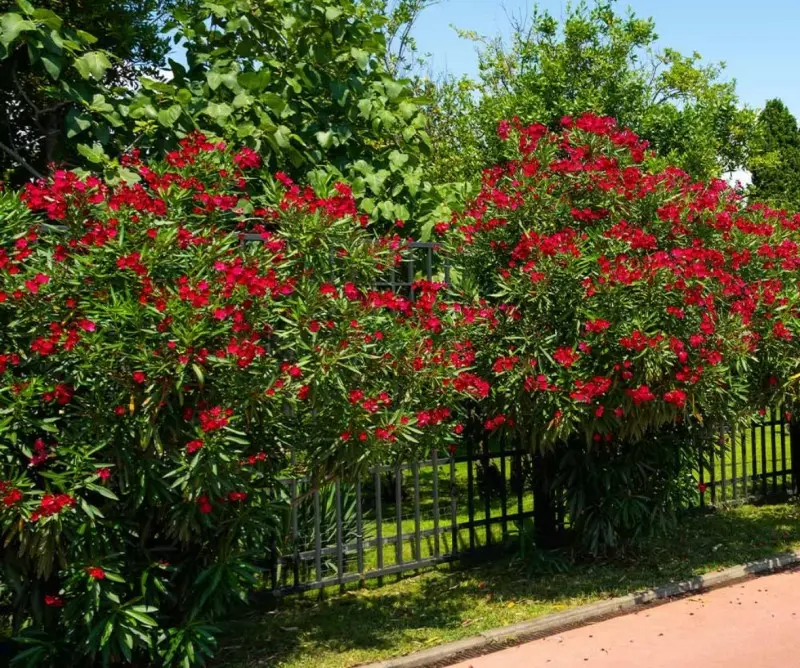
Oleander
$0.00
Full sun
-
5'-15'
Deer resistant
Oleander (Nerium oleander) is a robust, evergreen shrub or small tree renowned for its lush, dark green foliage and showy, fragrant flowers. Native to the Mediterranean and parts of Asia, Oleander produces clusters of large, trumpet-shaped flowers in vibrant shades of pink, red, white, yellow, and salmon. Blooming from late spring through fall, its long-lasting flowers add bold color to warm-climate gardens and are highly attractive to pollinators like butterflies.
Oleander typically grows between 6 to 20 feet tall and 6 to 10 feet wide, depending on the variety and growing conditions. This plant thrives in full sun and is hardy in USDA zones 8-11. Known for its adaptability, Oleander tolerates a variety of soils, from sandy to loamy, as long as they are well-draining. It is also highly drought-tolerant and salt-tolerant once established, making it ideal for coastal areas, xeriscape gardens, or other low-water landscapes.
Low-maintenance and easy to grow, Oleander requires occasional pruning to maintain shape and encourage new blooms, usually done in late winter or early spring. However, it’s important to handle this plant with care, as all parts of the oleander are toxic if ingested. Despite this toxicity, Oleander’s resilience, lush appearance, and profuse flowering make it a popular choice for creating colorful hedges, privacy screens, or dramatic focal points in warm-climate gardens. Its bold blooms and easy-care nature lend an exotic feel to a variety of landscape settings.

